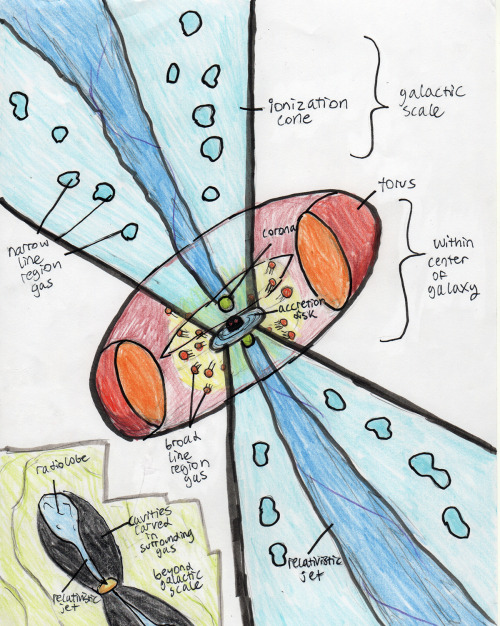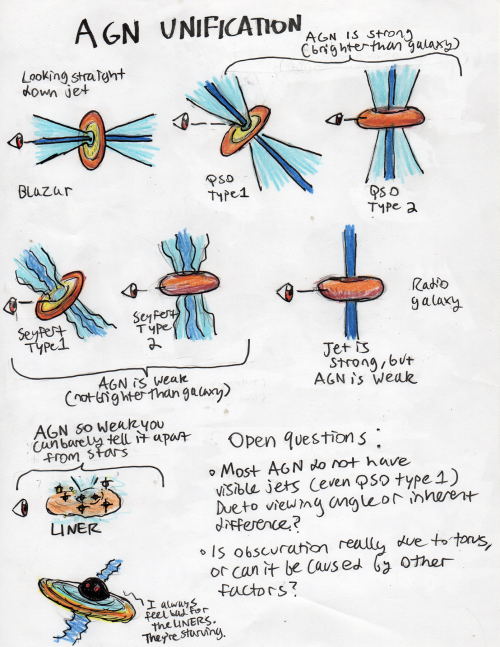#i want to give their black holes cookies
Some diagrams I hand-drew to use in the AGN planetarium show. My digital art software has been non-functional lately so I figured I might as well go back to colored pencil. The first page is just a diagram of all the structures associated with accreting supermassive black holes (AGN stands for active galactic nucleus which is how the actively feeding black hole manifests from the outside…as a bunch of weird activity in the center of a galaxy). The latter diagram shows the name of different astrophysical phenomena that are all thought to be due to accreting supermassive black holes.
For those that don’t know…
The supermassive black hole feeds from a whirlpool of plasma called an accretion disk. The accretion disk emits a lot of high-intensity ultraviolet light, which ionizes the galaxy in a broad swath called the ionization cone. The two main regions of ionized gas that are observed by astronomers are the broad line region (BLR) and narrow line region (NLR). The BLR is gas that is located close to the accretion disk in the center of the galaxy, and is thought to be moving rapidly, but observations are mixed as to whether the motion is an outflow (shown here), inflow, or simply rotation. The NLR is much more rarefied gas that occupies the ionization cone, and such extends through length scales comparable to the galaxy itself. All of these portions of the AGN features emit in optical light.
Sometimes astronomers can see the BLR and accretion disk light, but most of the time they cannot. To explain this, the AGN unification hypothesis posits that a thick ‘donut’ of cooler gas and dust–the torus–surrounds the BLR. When our line of sight is intercepted by the torus it blocks the BLR from view (”obscuration”). The torus radiates in the mid-infrared.
Just above and below the accretion disk is the corona, which is where UV photons from the accretion disk are boosted up to X-ray energies (hence why I have depicted them as the stereotypical radioactive green). The corona lies at the base of relativstic jets, powerful beams of fast-moving particles that extend out from the center of the galaxy and sometimes go on to punch into intergalactic space. When they do, they can carve enormous cavities into the gas that surrounds galaxies as they gradually slow down and pool into clouds of radio-emitting plasma called radio lobes. The jets are prominent in radio, but emit across the whole electromagnetic spectrum.
The weird thing about jets is that while AGN are famous for them most AGN do not have visible jets. This is why I have chosen to call the powerful AGN QSOs (”quasi-stellar objects”) rather than the more famous quasar. The word quasar comes from “quasi-stellar radio source” and was coined because the first discovered quasar had a prominent radio jet, but most quasars discovered since don’t emit in radio prominently.
The reason for this is unknown. It could be an orientation effect (similar to how we cannot see the BLR in most AGN), but it might also be an intrinsic difference since theoretical models show jets form only at certain accretion levels.
The other big AGN unification mystery is what the source of the obscuration of the BLR really is. Based on the vanilla torus explanation, one would not expect say, AGN in merging galaxies to be more heavily obscured than AGN in isolated galaxies, but this nonetheless is the case. Astronomers currently think obscuration can also be due to random dust clouds in the galaxy, not just the torus. And we don’t exactly know what the torus is either. Does it condense out of the material flowing into the supermassive black hole? Or out of it? Or is it some sort of ‘food reservoir” that the black hole can accrete from?
Post link


